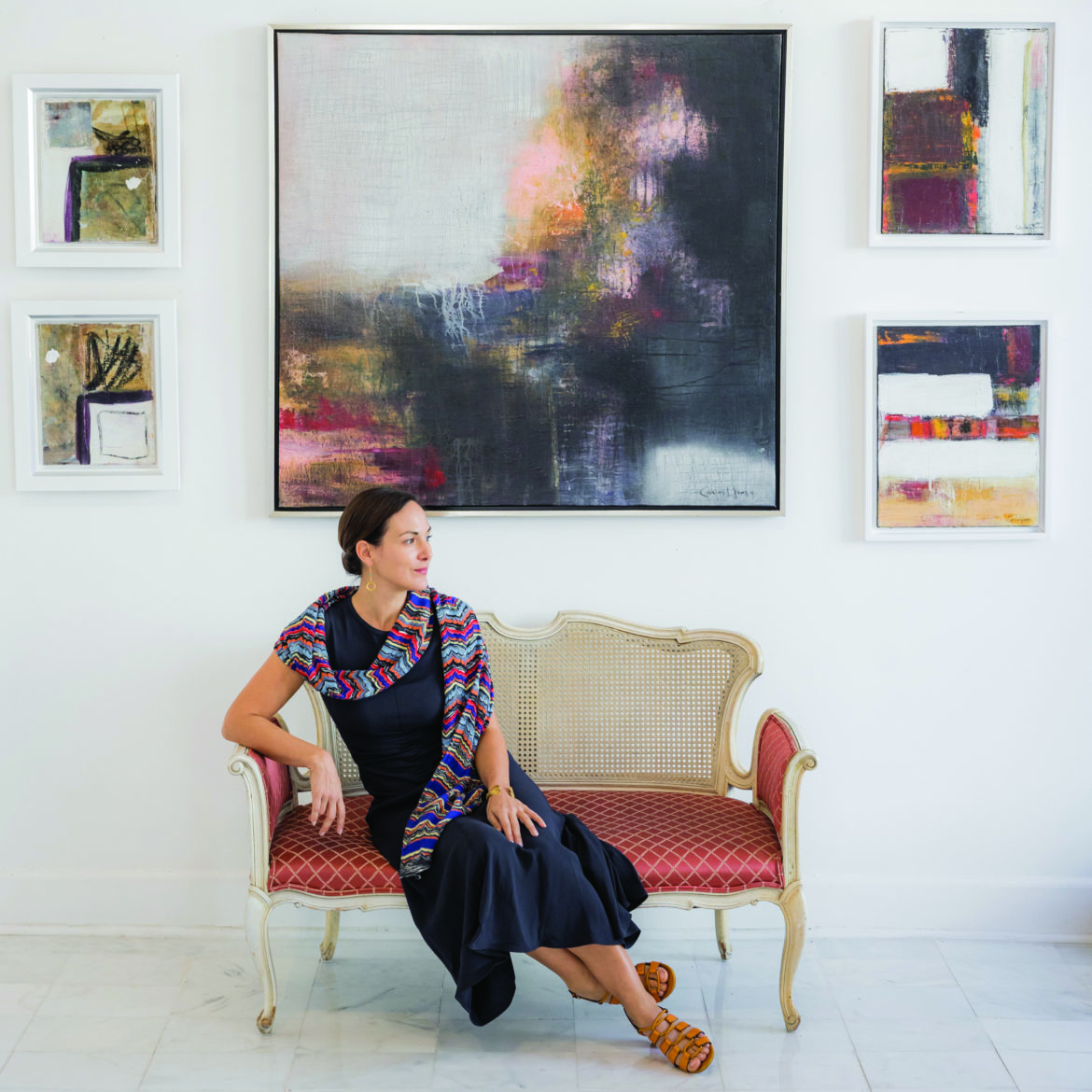Along with her partner, Joseph Knapek, German-born archeologist and art specialist CARLA GROH owns and operates Evey Fine Art, located at 240 South County Road in Palm Beach, Florida, where one can find works on display whose vibrant colors, emotional complexity and sheer scale of up to 9-feet make a striking statement.
Familiar with the intricacies of a globalized art market, Evey gallery opened with a an exclusively curated collection of the most outstanding Latin American Artists working to date, many of whom such as Dalia Monroy, Rigoberto Mena or Omar Guadarrama have long been considered a pinnacle of excellence and are themselves fervent supporters of younger artists within their communities. Gradually pushing to the forefront of the art market with rising auction results every year—Latin American art is no longer a best kept secret among art collectors and has arrived at the heart of a newly emerging art scene in Palm Beach.
Evey is an absolutely stunning gallery. Your studies were in Europe?
Yes. I studied in Basel, Switzerland and in Freiburg, Germany.
Switzerland. Let’s start there.
I love Switzerland. I grew up and studied there and spoke primarily Swiss German until I was four or five years old. To this day I still have friends living there.
Where were you born?
I was born in a tiny corner of Germany, right next to the Swiss and the French borders.
Have you spent much time in France?
Yes. I also lived in France in the Alsace region, which is in the Rhine region, right next to Germany and Switzerland.
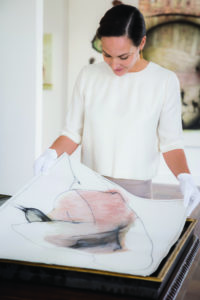
Three very beautiful, but different cultures, and very different people. What is a characteristic, quintessentially unique in the German culture?
I read a philosopher once, who said, “You never realize how much your environment influences you until you leave that environment and move somewhere else.” I was never able to really pinpoint what was quintessentially German until I moved to Greece. It was there that I realized they are reliable. If they say something, they do it. It was something that I took for granted and thought of everybody else. When I moved away, I realized that was not the case. Culturally, this is something I miss the most.
Then the Swiss?
What I love the most about Swiss culture and what I learned when I was working there and attending the university is that their way of communicating is very respectful. They always let you finish your sentence and don’t overwhelm you with putting too much information in one sentence. They have a very equalizing way of talking to each other.
Gentility, isn’t it?
Yes. And it results in creating a great environment to work in and to be engaged in professionally.
Tell me about your father, he is no longer with us. How long ago was that?
No, when I was very young, still a baby.
And your mother?
My mother lives in Vienna and also in Switzerland. She is a great influence, and we are very close.
Did your mother feed your passion and love of art by giving you access to museums?
Yes, my mother and my grandmother. They both made certain that I was exposed to a lot of culture, opera, and museums. Every church we would pass, I would have to go in and they would quiz me about the style. It was something that felt like a game, fun and with a destination. It was something to look forward to on the weekends.
You have traveled and lived all over Europe; Greece, France, Switzerland, and Germany. What about Paris?
Yes. When I was young, we often visited friends living there.
Do you recall the first time you saw the Mona Lisa?
No. I do remember the Louvre as being really crowded. I do remember the first time I saw Monet’s Water Lilies. My mother always said, she could leave me at the museum for hours. I would just sit there and soak it in. It gave me so much joy and calm. I loved it. In the stressful city of Paris, it was a lake of tranquility. I also loved the Tinguely fountain. It was always the first thing I ran to; the sculptures, like the little elephant. Art was something that has always filled me with joy, and I looked forward to seeing. It was a great adventure and I loved it.
As a child did you think your profession would be in the world of art?
No, I didn’t. As a child, one of the earliest memories I have was when I wanted to be an archeologist. I don’t really know where that idea came from either. From a very early age, and I wanted to be a scientist, an explorer, who was paired with a sense of adventure. I wanted to see other countries and to uncover mysteries. I was inquisitive and my dream was to have the freedom to do this.
What was your favorite archeological expedition or “dig”?
It was in Greece with a German archeological Institute and is called Kalapodi, a sanctuary about 90 miles west of Delphi. Supposedly, though not a hundred percent certain, it is an Apollo Artemis sanctuary. We were excavating adjacent buildings around the main temple which had been already excavated. We did this over years in different campaigns.
Egyptology is one of your fields of study. Did you participate in any expeditions in Egypt?
Yes. I was on two expeditions with a group in the Sinai region using camels as our transportation and Bedouins as our guides to a sanctuary up in the mountains called Serabit el-Khadim. It was an old silver mine with a temple, and it became part of my studies later on. That was one of the most beautiful experiences of my life.
Excavating a silver mine, ostensibly dating to the time of the pharaohs, was it pre-Christ?
Yes, 1500 BC. The excavations were in different phases much like the buildings. There was a very primitive early phase and then it grew from there. Later, new buildings were added to the temple.
How were they able to move the silver?
Probably by camel. They are sturdy beasts. If you have ever seen one, their hooves are gigantic, and they can really carry a lot. They are also very agile and know how to walk on sand and stone. Silver was mined there 3000 years before Christ. They had trading relations as far as Pakistan.
Did you develop a love for the Bedouin people, their nobility and beauty?
What I found the most striking about the Bedouins was their incredible sense of humor. I laughed so hard with them. They had an amazing sense of self and a clever self- irony that was hilarious. They thought it was funny, how Westerners approached and thought about them. We would sit down and have a great laugh. They would cook for us on the open fire. We really felt that we were in their homes, and they were our hosts. I have a lot of respect for their culture, and for their religious practices. They are a very spiritual people.
They regard women highly, which is not what you would expect.
For women, mothers, especially. We talked to their wives, and they also had a great sense of humor. Having multiple wives is an accepted practice, and one of the wives once told me she was glad because he was gone most of the time, so she had the house to herself. The experience taught me to never judge another culture with your own personal view of things, you have to respect other people’s ways and their traditions.
Did you wear a burqa when you were working there, or did you dress Western?
I wore a head scarf, so I was not showing my hair.
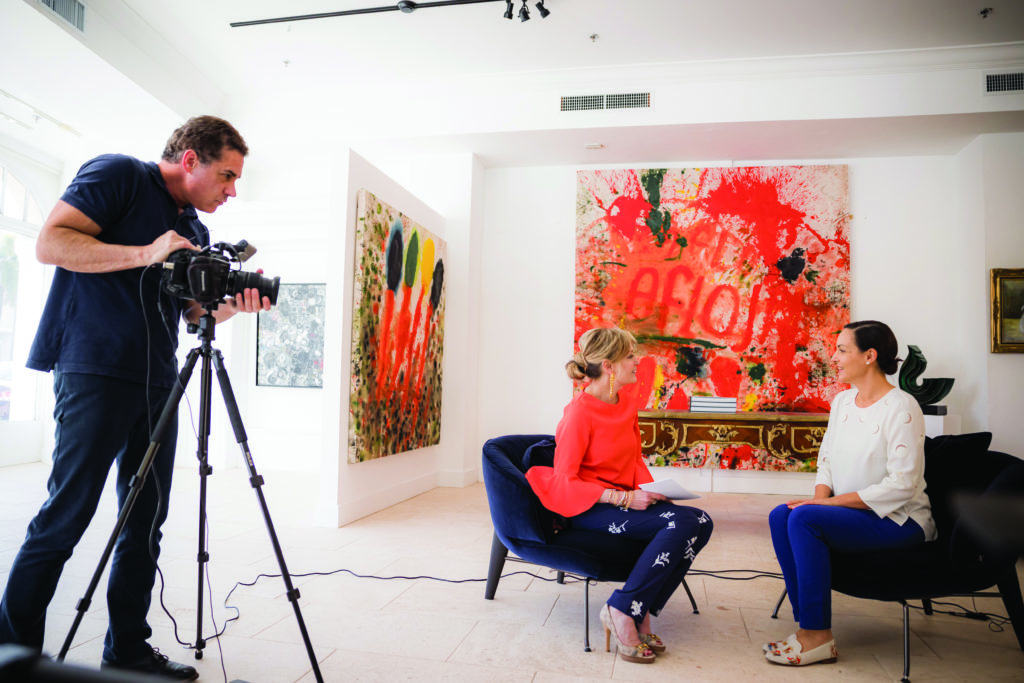
Did you ever consider being an architect?
No, I don’t think it ever crossed my mind. It was too technical for me. I was drawn more to the scientific side. I wanted to explore ancient cultures.
Two archeological tours in Egypt, a minimum of one tour in Greece. Were there any other locations where you did archeological excavation?
No, I kept coming back to Greece, to that sanctuary. Whenever possible, I would go back to that excavation.
What was it about that, the sense of exploring the history and lineage of your father?
I think it was more the team that I really loved, the work and my colleagues. On each occasion, we had an incredible time there. It was one of the happiest times of my life. We would spend the weekends in Athens, which remains one of my favorite cities.
And how old were you at that time?
I began in my twenties and I kept going back until three years ago.
Archeology to the world of art, auction house, brokering art? Help with the chronology.
In my second year at the university, I realized that turning archeology into a profession was very difficult. It was a real obstacle to do what I loved without a source of income. A friend of mine suggested doing something in the art industry. He put me in contact with the first gallery I worked for in Basel, which was an antiquities dealer. I started working there 18 years ago, while in pursuit of my studies for over five years.
How does one curate antiquities?
The rule for antiquities is that they must have provenance that goes back to 1960s, 1970s. To be legal, the antiquities that are traded now, have to be on the market for a certain amount of time.
Which is difficult to do?
Yes, it is not easy as a business. To do it properly you need a research team of two or three people who do nothing but research the backgrounds and the type of pieces. You want to make sure that all the pieces entered the trade legally. It was completely legal in Greece to sell whatever you found.
But now?
No, not anymore. So right.
Essentially, from the sixties forward countries that are doing excavation prohibited what is discovered in the expedition being sold on the open market. What is discovered is owned by the country of origin, which is why the museum in Egypt is so spectacular.
Yes. and they only have a fraction of those on display. They just discovered a new tomb in the Valley of the Kings, led by people I know from the University of Basel. That is what makes archeology exciting, you can always find something completely new. You can find a new civilization if you dig deep enough.
What happened after working for the antiquities dealer in Basel?
I moved to Vienna, and I started working in another gallery and I was a research fellow for a university project.
Do you like research?
I do.
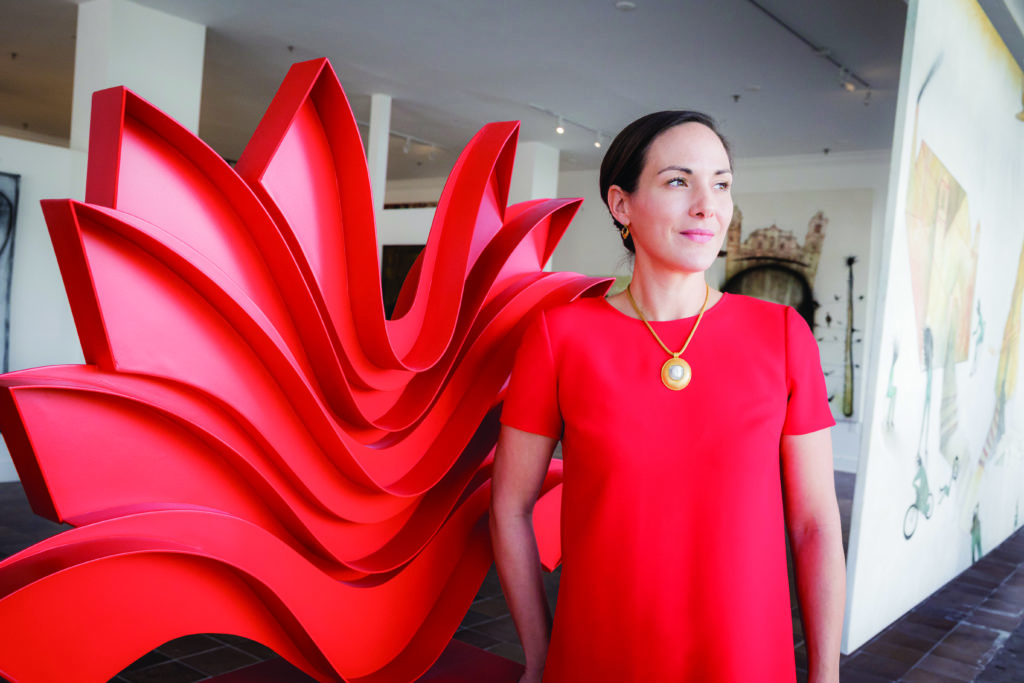
If you had a choice between curating art, researching antiquities and owning a gallery, which is your favorite and why?
Definitely owning a gallery and researching for fun or on the side. Academia, as much as it fascinated me, and as much as I liked it, was not a hundred percent for me. As it turned out I was a horrendous academic writer. Sometimes you think a job will be perfect but once you engage you then realize it does not fit a hundred percent. When you realize that it forces you to change directions.
Archeology, curating antiquities, then working in the academic world, what happened next?
I worked in Lucerne for a period of time, as an expert for an auction house. I returned to Vienna again to work for a gallery, which is where I conceptualized Evey.
What does Evey stand for?
Evey is from my Greek grandmother’s name Evangelia, which means the gospel or the good news. Evey is also a fictional character that I always liked and one who inspired me. The name just came to me one day, and it stuck with me. The idea started as a limited-edition art store, which would sell limited edition prints for artists all over the world. It took me several years to develop the idea and to actually have the courage to begin. I slowly started with my own art brokerage. Evey moved from Vienna to France, and then from France to Chicago. We eventually moved to Palm Beach, which was a spur of the moment decision, leading to our first brick and mortar store. From there, it developed into what we see here.
While you worked in an auction house, I presume you learned the evaluation of art?
Art appraisal was very interesting because it was such a different world than what I knew. I learned in Switzerland to treat art as a financial asset, as well as an aesthetic asset in your house. I found it very interesting to have the best of both worlds, to have an asset you can invest in while at the same time an asset you can enjoy, that you collect. The auction house taught me about evaluation and also about working very fast with a lot of objects.
Can you share Mr. Vanderbilt’s Performa on wealth?
To have an even portfolio, 30% of art as an asset and then 30% of real estate and 30% of stocks and bonds.
Do you believe that still applies in today’s world?
In Switzerland in 2008, we had a gallery in St. Moritz. That formula was very true for a lot of people, and it was a very busy year for us. Art is also a secure way of investing, and it is portable because it is an asset that can be easily moved. You cannot move a house for instance. An increasing number of people, over the last 20 years, have started investing in art, even though they are not professional art collectors.
Is art valuation contingent on there being a finite number?
Definitely, because with scarcity, only a certain number of pieces on the market remain, which translates to a consistent valuation. That stability also guarantees a certain value.
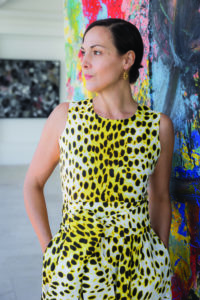
Tell me about the art surrounding me in this absolutely spectacular gallery?
Latin American art is mainly what surrounds us, Cuban in particular. Working with artists is a particularly important component to what I do. It is important for me to work with artists with whom I have a personal relationship, that are truly dedicated to their work, to their craft and who have very established careers. It is just a pleasure.
Forgive me for asking, but is there a piece in here that you consider your favorite?
Yes, it is in the back and is called the Shared Soul. It shows a woman holding a dog. The artist, Ruben Rodriguez, explained to me that he depicted the moment of two souls bonding, a human and an animal, which is the kind of art that I gravitate towards: art with soul, emotion, and deep meaning.
How many pieces are currently in your collection?
Right now, I would say approximately 80.
How do you sell this amazing art? The bricks and mortar show room here at the Evey gallery or e-commerce?
Primarily people coming to the gallery and clients we already know. The gallery’s visibility also plays a big role. Palm Beach is a great place to connect with people who collect and really appreciate art. They span the entire east coast to LA. Everyone that comes through here sees us, which is a great way to reach the right clientele.
You mentioned when you were a little girl, you fell in love with the “joy and peace” art brought to you. Can you describe that experience for me?
You might call it transcendent or a metaphysical place that is inside you, but art can touch that place and is also all around us. Once you really connect, art can charge you in certain ways. Art can fulfill you or heal you or transform you. That for me is the most rewarding and fascinating thing…if that connection happens, if you find that piece of literature or that movie or that painting, that touches you and makes you feel whole or less alone or understood. Marilyn Monroe once looked at a painting from, I think it was Goya, and it was a terrible scene. She turned around and said, “Oh, he knows my nightmares.” I think this is how a lot of people connect with art. They feel understood. They feel like there is a place that we do not necessarily share, but we all experience as part of the human condition. Sometimes that “place” cannot be put into words, it can only be put in poetry or art.
You use the word “transcendent,” do you believe artists are given a gift from God?
I do.
Is there a responsibility associated with being given that gift?
That is a good question. I would love to know for sure my purpose or my path. I think sometimes you have to walk the journey to find out.
What do you think is your responsibility?
When I look around sometimes, I feel it is to create a space for everyone, but especially a space where… I find it hard to put it into words.
Keep going. Is the word describing the space that you are searching “safe”?
Yes. What strikes me the most is what a lot of people say when they come in here or when they see the artwork. They usually make a comment about the effect it has on them which gives me the greatest sense of accomplishment. To have created a space where people can have that connection or sensation that I had as a kid. Art has always had that effect on me, and I felt that art was something that could really touch you deeply inside, that sacred space. The world can access that space and yet it is kept sacred and nourished and developed. I think every one of us needs a safe space to create.
When was the first time you saw your husband?
We met years ago at an art show where we talked about art, French cheese, and wine. We connected and that was the beginning of a long journey.
How old were you at that time?
I was in my early thirties.
Did you know that he was “the one”?
I never bought into the idea of “the one”. It is a romantic concept that I never really believed. I have experienced the emotion, when someone feels so familiar, as if a bond was rekindled that had been going on forever. When I met my husband for the first time, it felt so familiar talking to him as though we were continuing a conversation from a little earlier. This feeling of finding a kindred spirit, I have experienced, but I don’t think it happens just one time with one partner. I also have experienced it with great friends, great business relationships and even artists. The connection feels as though the relationship is how it is supposed to happen. We were meant to work together or be together and walk this journey together, if that is what we believe.
Do you share your passion and calling?
He loves our artists and is very passionate as well about the gallery and building the space. He pours his heart and soul into it, just as much as I do.
How many hours do you work a day?
I would say at least 12. 10 to 12?
Is there one person, above all others in your entire career, that either took a leap of faith with you, supported your dreams, or pushed you beyond what you imagined possible?
I would definitely say my husband. He was the one who pushed for this. I am naturally more careful, deliberate and a slow decision maker. I thought we would start with an art brokerage, not with a gallery or brick and mortar store. My inclination was to bring pieces over from Europe and see how it went. He was always the one, and still is, who pushes for expansion and to take risks. I think one of the best things I have learned from him is to take risks.
What do you want to accomplish in the second chapter of your life?
I do have some projects that are very close to me, that I still want to realize. The skillset that I learned starting this business and building this business has helped me to develop the tools that I need to make the vision a reality. I just lacked those skills in the beginning. I did not know how to turn an idea into an actual enterprise.
What for instance?
I would love to publish my research. I also want to develop the Evey Edition, and the e-commerce part of the business. Our limited editions line is focused on younger, emerging artists all over the world that have the opportunity through Evey edition to send us their files. We then sell their artwork here so that they have an income, wherever they are. We have artists in Ghana, Pakistan, Latin America and Europe. Another dream of mine is to develop and expand that network further.
You currently have an e-commerce online, so you want to expand it…be more robust?
Yes. To grow our footprint globally and to get more and more artists on board.
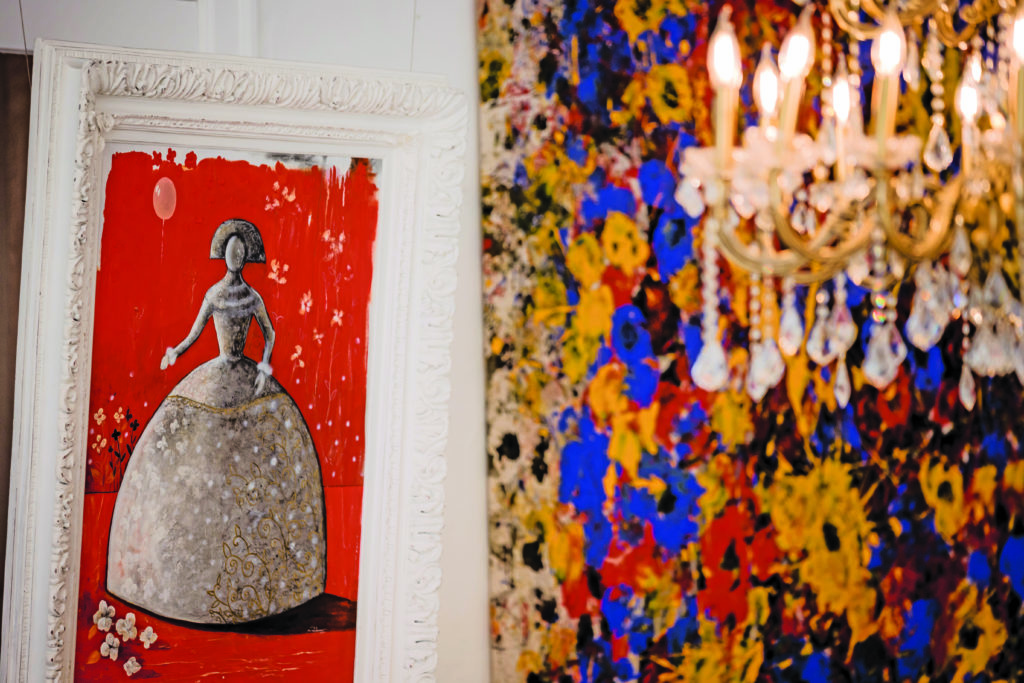
How does one go about actively recruiting those artists and build those relationships worldwide?
To grow and expand, we will have to hire more people, a whole team to maintain the website, and open offices in different cities.
Publishing and growth through e-commerce and physical sites. What else?
Those are the main focuses right now, and eventually public speaking, which is also something I really enjoy doing. I learned that I enjoyed that from time at universities. I really do enjoy presenting facts in a fun and interesting way.
For what do you want to be remembered?
Creating that safe space that we talked about earlier. That would be the legacy I would be most proud of. If Evey were still here and people knew it was that space available for everyone to feel connected to art and feel safe. That would be something that would make me very happy to have as my legacy.
Do you envision staying in this spot for many years?
Yes. Definitely here, but I am sure there are more spots to be discovered.
What experience can you share, that you wish you would not have had to learn the hard way.
In life, sometimes the obstacle is in the way of your dream. As long as you do not quit but continue to work on what you see as a terrible challenge, you can work through it. The result can easily turn out to be exactly what you need it to be. “Persevering” separates you from the majority because if you work through the challenge, you will find yourself in a unique space, because not many people can get there. I wish I had known that sooner. While you are fighting your way through, it seems hopeless, silly, or insurmountable at times. Looking back, it is easier to connect the dots. I realize now that had I not run into the challenges of financially sustaining myself as an archeologist, I would not have had this career. I had been told so many times “you can’t do this”… or “what you are trying is impossible”. Those words sparked something inside of me and created a stubbornness to try it anyway. Often, the people standing in your way or a difficulty standing in your way, is really what “makes you” and is a blessing in disguise. Even if you turn down the wrong alley, at least you have walked your life’s path and it will show you where next to go. Never lose that faith. I think this is the lesson I would tell a younger version of me. There is a meaning to all of this, and it is not for nothing. Everything will make sense in the end.
If you could ask God one question, what would that be?
What would you have me to do?
Your purpose?
Purpose. Yes.
I think you know your purpose, Carla.

